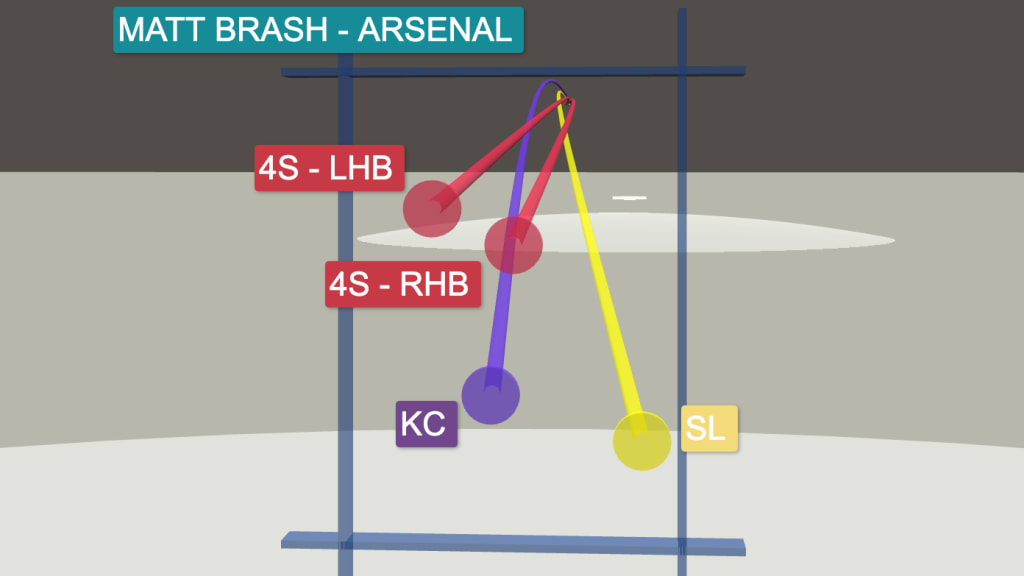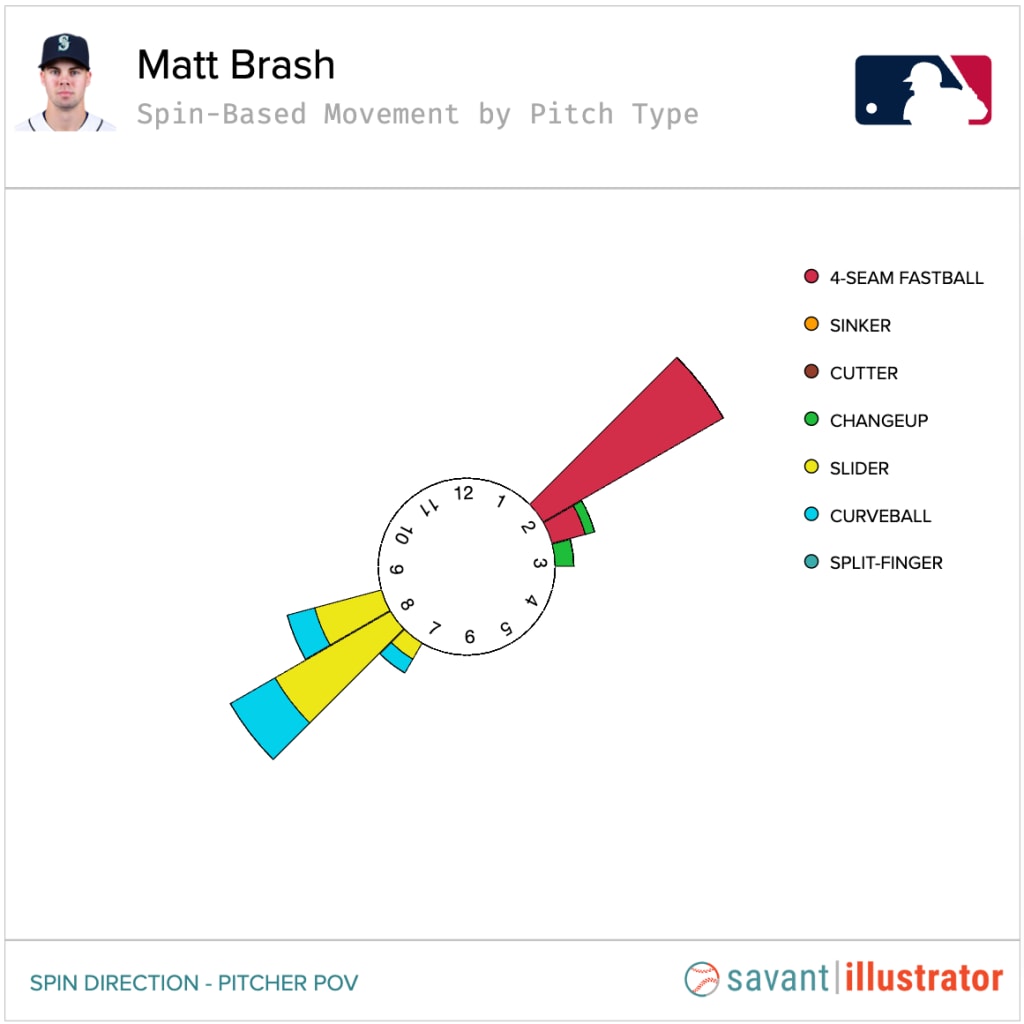Matt Brash could be the nastiest new pitcher of 2022. His stuff is insane. And he just gave us some amazing insight into why.
The Mariners rookie broke into their starting rotation thanks to a video-game arsenal. Brash's fastball-curveball-slider troika has been all over Pitching Ninja's popular social media feed, and this week Brash joined him for a wide-ranging interview that's worth watching.
Brash broke down all his different pitch types, how they move and how he uses them to attack hitters. It's a cool inside perspective from a young pitcher who could become one of the nastiest in the league -- and thanks to Statcast, we have all the data to break down what Brash said.
Here are some of the most interesting topics Brash hit on -- and the numbers behind Brash's nasty stuff.

The slider movement
"It feels great in my hand. It's like my favorite pitch to throw -- it just feels like you're gonna throw a nasty pitch."
Every pitch Brash throws is nasty. But the slider looks like it's the nastiest. Check out the movement numbers.
- Vertical drop: 41.4 inches (+4.3 inches above avg.)
- Horizontal break: 16.9 inches (+9.6 inches above avg.)
Brash's slider drops over four inches more than an average slider, and it breaks almost 10 inches more than an average slider. The horizontal movement, in particular, stands out.
Sliders with most horizontal break above avg. in 2022
- Ethan Roberts (CHC): +11.1 inches above avg.
- Drew VerHagen (STL): +10.0 inches above avg.
- Shohei Ohtani (LAA): +9.8 inches above avg.
- Matt Brash (SEA): +9.6 inches above avg.
- Brooks Raley (TB): +9.5 inches above avg.
Compared to sliders thrown with similar velocity and release point
Brash's slider has gotten as much as 23 inches of horizontal break. That slider struck out José Abreu. His next-sharpest slider had 22 inches of break. That one struck out Luis Robert.
Brash is notably right next to Ohtani on the movement leaderboard. Both their sliders are thrown at the same speed, and they break nearly the same amount -- Brash's moves about 17 inches right to left, Ohtani's moves 16 inches. But Brash's slider has more of a two-direction movement, as it drops eight inches more than Ohtani's.
That makes sense. Ohtani's slider is designed to dovetail with his splitter -- they drop the same amount, but break away from each other. Brash's slider pairs with his curveball.
The high-spin knuckle-curve
"I've always been able to spin the ball really well … Growing up, I would just, every day, throw a tennis ball against my garage door and the roof of my house. And I would just spin the ball."
Brash's knuckle-curve looks a lot like Brash's slider, but slower (82.7 mph vs. 84.7) and with more up-and-down movement:
- Vertical drop: 50.5 inches (+3.4 inches above avg.)
- Horizontal break: 14.1 inches (+3.1 inches above avg.)
That's well-above-average movement in both directions. But the vertical is more pronounced than the slider (nine inches more drop) and the horizontal is slightly less (by three inches).
Brash, as he says, is a high-spin pitcher. That spin does more for his curveball, which is averaging 2,931 rpm (his slider is 2,793 rpm).
Highest avg. curveball spin rate by SP in 2022
- Kyle Hendricks (CHC): 2,994 rpm
- Charlie Morton (ATL): 2,993 rpm
- Chad Kuhl (COL): 2,962 rpm
- Matt Brash (SEA): 2,931 rpm
- Aaron Civale (CLE): 2,893 rpm
MLB avg. curveball spin for SP: 2,466 rpm
Here he is striking out Eloy Jiménez, Leury García and Reese McGuire with curveballs at 3,070 rpm, 2,956 rpm and 2,955 rpm.
The fastball/breaking ball combo
"Robbie [Ray] pretty much throws two pitches. And I feel like, for the most part, I throw two pitches. My curveball and slider are different shapes and stuff, but for the most part, that's what I do, too. So I've been trying to pick his brain, and he just says to dominate two pitches. Be really, really, really good at two things, and that's all you really need."
That brings us to the other of Brash's "two" things: his four-seam fastball. He's throwing it in the mid-to-upper 90s -- averaging 95.8 mph and topping out at 99.2 -- with a full foot of arm-side run, over three inches more than an average four-seamer.
When he elevates his fastball, the pitch explodes past even top contact hitters like Michael Brantley.
Brash's four-seamers tunnel naturally with his breaking balls. He throws them all the same way, as hard as he can, every time. But depending on where he positions his long, hooked fingers on the baseball -- watch the interview to see Brash's grips -- the baseball moves in all different directions.
Pitch shapes
"[The Mariners have] just let me do my thing, but have given me information toward my pitch shapes and my locations and all that stuff that I've never really had before."
Brash might not focus on pitch tunneling when he attacks hitters, but the way he spins his fastball and breaking balls, they absolutely play off each other.
The spin axis of Brash's four-seamer mirrors that of his slider and curveball -- that means they spin in perfectly opposite directions out of his hand, which makes it harder for the hitter to distinguish which pitch is coming.

Picture a clock face. Brash's four-seamer spins toward 1:30, and then rides up and to the right. His slider and curve both spin toward 7:30, directly across the clock, and break down and to the left. The delay for the hitter that comes from the mirrored spin before the pitches diverge can make all the difference.
Locating and attacking
"I had been trying to spot up my fastball on corners, and throw my slider down-and-away every pitch. [The Mariners] were just like, 'You don't have to do that. You just have to fill up the zone. Have your catcher set up middle, and you're not gonna hit middle every time, you're gonna spray the ball.' So I pretty much have the catcher set up middle, and I throw my stuff full-effort."
Brash's biggest issue in the big leagues so far has been throwing strikes. He has seven walks to his 11 strikeouts. But that's also a reflection of how much his pitches move … which is why, in that same start, he also had a no-hitter into the sixth inning. That's also why he targets the middle of the zone and lets his pitches take off from there.
If he can command the strike zone, he could be unhittable. When hitters swing at Brash's pitches, they whiff 30% of the time, but they're only swinging at 39% of his pitches, well under the league average of 47%. They're not chasing a ton either, despite how sharp his stuff is.
About one in five two-strike pitches Brash has thrown has put the hitter away for a K, just a hair above league average. But Brash has way better than league-average stuff.
The Mariners pitching staff has a motto: Dominate the zone. Once Brash dominates the zone, he's just going to dominate, period.


